Asphaltene Formation Damage Stimulation by Ultrasound: An Analytical Approach Using Bundle of Tubes Modeling
Abstract
This study presents a novel approach for bundle of tubes modeling of permeability impairment due to asphaltene-induced formation damage attenuated by ultrasound which has been rarely attended in the available literature. Model uses the changes of asphaltene particle size distribution (APSD) as a function of time due to ultrasound radiation, while considering surface deposition and pore throat plugging mechanisms. The proposed model predicts the experimental data of permeability reduction during coinjection of solvent and asphaltenic oil into core with reasonable agreement. Viscosity variation due to sonication of crude oil is used to determine the fluid mobility applied in the model. The results of modeling indicate that the fluid samples exposed to ultrasound may cause much less asphaltene-induced damage inside the porous medium. Sensitivity analysis of the model parameters showed that there is an optimum time period during which the best stimulation efficiency is observed. The results of this work can be helpful to better understand the role of ultrasound prohibition in dynamic behavior of asphaltene deposition in porous media. Furthermore, the present model could be potentially utilized for modeling of other time-dependent particle induced damages.
1. Introduction
Ultrasonic waves have a wide variety of applications in the oil field industries. Special characteristics of these waves such as high frequency and performing cavitation have brought them forward as a unique gadget in many stimulation operations [1]. Ultrasound radiation can change the molecular weight of asphaltenes. Lin et al. [2] applied ultrasonic waves to crack refinery oil residue which contains high amount of asphaltenic components in the presence of abundant hydrogen. Because of the local microscale high pressure and high temperature created by ultrasonic cavitation, asphaltene cracking can be even done in the atmospheric pressure. Dunn and Yen [3] successfully converted about 35% of asphaltene into gas oil and resin fractions under very mild condition using the ultrasound power and its cavitation feature. Kang et al. [4] published experimental results discussing the effects of ultrasound frequency on changing the average molecular weight of asphaltene content and showed that there is no direct relationship between frequency and capability of breaking down the asphaltene molecules.
The viscosity of asphaltenic oil can be changed by radiating ultrasonic waves. Islam et al. [5] ran experiments to ascertain the relationship between asphaltene content molecular weight and bitumen viscosity. They showed that oil viscosity significantly increases if containing more asphaltenic heavy components. Consequently, by accepting that ultrasound can crack the asphaltene molecular chains, it can also reduce the viscosity of oil. Chakma and Berruti [6] reported 15% viscosity reduction of heavy asphaltenic oil samples after radiating the ultrasonic waves.
The viscosity of colloids is related to the size distribution and stability of their dispersed particles [7]. Zhang et al. [8] studied the effect of ultrasonic waves on the stability of asphaltene emulsion and, by comparing the data before and after ultrasonic treatment, they found that the colloidal stability of asphaltene improves and it is mainly a physical process.
Mousavi et al. [9, 10] discussed the applicability of ultrasonic waves on the reduction of asphaltene flocculation. Najafi et al. [11] observed the results of ultrasonic irradiation on asphaltene particle size distribution (APSD) and found that the average sizes of asphaltene particles can be mitigated if they were exposed to the ultrasonic waves for specific time. Rad et al. [12] developed a model describing the behavior of asphaltene flocculation kinetics to show that ultrasonic exposure can reduce the asphaltene flock size after passing an optimum time of sonication.
Although it has been shown that ultrasonic waves positively affect the size of asphaltene particles, fundamental understanding of how formation damage induced by asphaltene deposition can be inhibited under the influence of ultrasonic waves is not well understood. Here, a bundle of tubes-based model is developed and used for predicting of formation damage inhibition under the influence of ultrasound. Most of previous dynamic models of permeability impairment cannot take into account the role of ultrasound prohibition on asphaltene precipitation; especially they suffer from the weakness in considering the role of APSD in the model behavior [13–15]. Here, the experimental data of APSD available in the literature measured by confocal microscopy at different ultrasonic exposure times is used for the modeling of permeability impairment in asphaltene-induced damage formations.
2. Methodology
2.1. Damage Prediction
In order to predict the formation damage, an appropriate permeability modeling should be done as well as considering the particle migration and deposition mechanisms. Stein [17] is almost the pioneer in combination of bundle of tube model and filtration theories to describe particle entrapment mechanisms inside the porous media. Modeling of the asphaltene-induced damage is mainly based on the theories of fine particle straining and clogging inside the porous medium. Here, to predict formation damage, bundle of tubes model is used.
2.1.1. Bundle of Tubes Modeling
2.1.2. Asphaltene Particle Size Distribution
2.1.3. Filtration Theories
Fine migration in porous media occurs in three main patterns. For the particles larger than the average size of the pores, migration cannot be observed. As a result severe particle deposition occurs and permeability reduces significantly (Figure 1, Case I) [31].
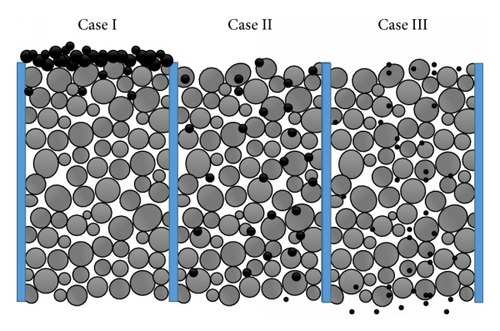
2.1.4. Formation Damage Dynamic Modeling
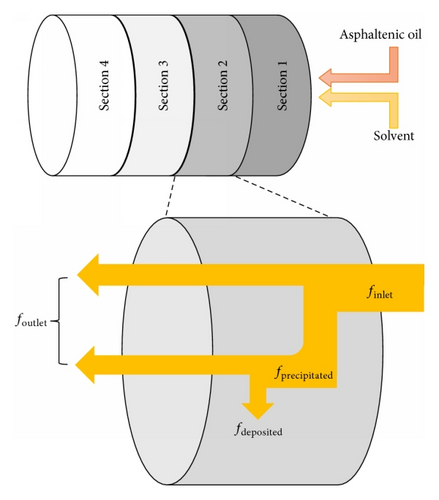
Figure 3 illustrates 10 sections of a hypothetical porous media simulated for one pore volume injection. The black strips on each section indicate blocked area by asphaltene deposition. It is expected that the first sections experience more asphaltene deposition than the last sections. The first section experiences nine time steps of asphaltene deposition and this leads to massive permeability reduction in this section. The next sections, respectively, face lighter deposition because of the less remained particles in fluid.
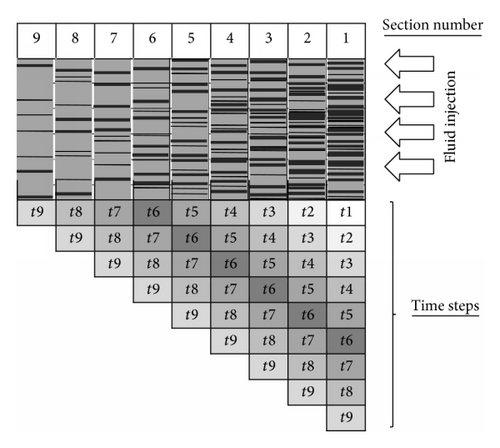
It is predictable that particle deposition is more severe in the initial sections because when the large particles arrive initial sections they got deposited and do not infect the next sections. In the present study, four sections have been considered for the medium. During the injection, average particles size enhanced because of the asphaltene flocculation, so it is important to find the relation between size increment and time to determine the size of particles involved in deposition process at each moment. Figure 4 presents the results of simulation on the specific rock core discussed in the paper and as it can be seen by dividing the medium into four sections, one could conclude that primitive sections contain higher number of the deposited asphaltene particles. Also, Figure 5 shows the mass content of asphaltene particles deposited in each section versus injected pore volume of solvent and crude oil. It seems that the amounts of asphaltene content in each section are approaching a maximum value which is related to the maximum possible amount of asphaltene precipitation for the specific sample of crude oil.
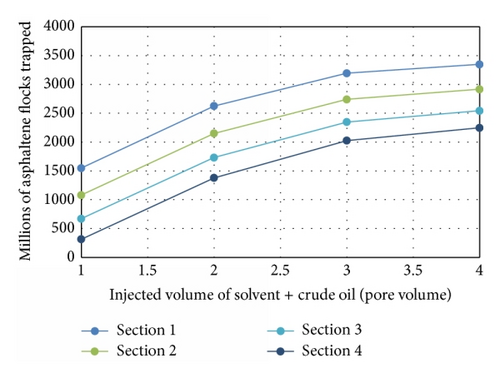
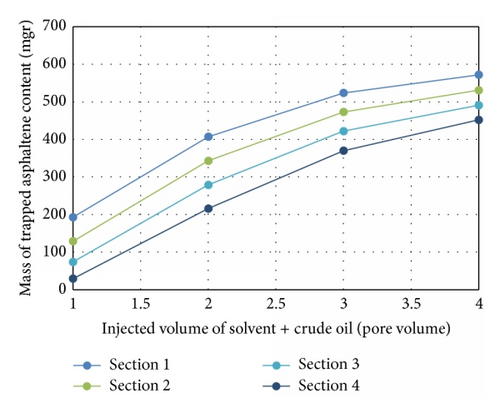
2.1.5. Hydraulic Radius Approach
The hydraulic radius is a measure of channel flow efficiency. Based on the constant shear stress at the boundary assumption, the hydraulic radius is defined as the ratio of the channel’s void volume to its wetted surface area [36].
2.1.6. Permeability Impairment
To sum up, the procedure of damage modeling during asphaltene deposition is clarified in Figure 6 within the flowchart. The simulation continues until mass balance equation is solved for all sections and all time steps.
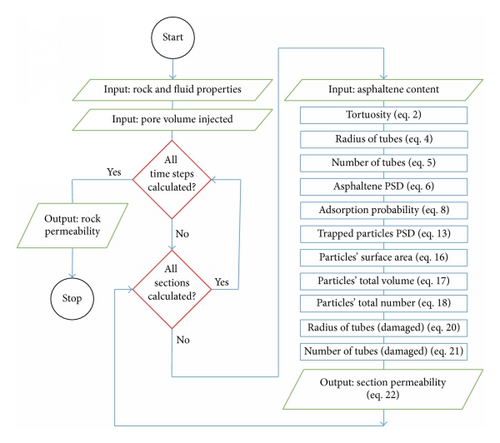
2.2. Ultrasonic Stimulation
2.2.1. Alteration of APSD after Sonication
The size of the asphaltene flocks is an important factor in modeling the deposition because larger flocks are more prone to settle and form deposits [37]. Asphaltene exposure to ultrasonic wave can change its molecular and structural properties [6]. Besides, according to previous studies, sonication can change the kinetic of asphaltene flocculation from irreversible to reversible [12]. Figure 7 presents the PSD of precipitated asphaltene in the mixture asphaltenic oil and n-pentane after 5 min of mixing. In this case, by increasing the sonication time, the average size of particles is reduced.

Najafi et al. [11] showed experimental results of asphaltene flocculation and the kinetics of aggregates creation after ultrasonic exposure by adding specific ratio of alkane as the solvent. Ultrasonic radiation was applied using a wave generator with 45 kHz frequency and 75 W output power. Their experiments have shown that sonication firstly causes an increase in the size of aggregates. But after about 90 minutes after the beginning of flocculation, a reduction in aggregate size of sonicated samples is observed. Flocculation time starts at the moment that oil and n-pentane are mixed. Figure 8 illustrates the change of particle size versus the flocculation time in different sonication periods. Asphaltene average particle size increases uniformly for the case of nonsonicated oil by passing the flocculation time. In the sonicated samples, particles’ average size has begun to decrease after about 90 minutes of flocculation time. In a different aspect from Figure 8, Figure 9 presents the effect of sonication time on a single sample after passing different time steps of flocculation. Despite of a slight increment in asphaltene particle size by passing the sonication time, in an overall view, average particles size is decreased significantly after 40 min of sonication.
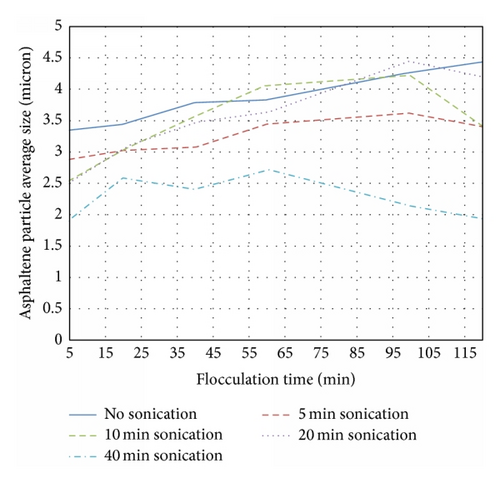
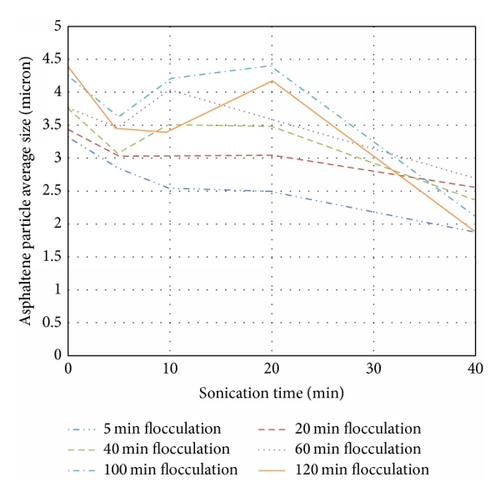
2.2.2. Viscosity Behavior of Sonicated Asphaltenic Crude Oil
Najafi et al. [11] have published experimental results showing the viscosity variation of asphaltenic crude oil under different time intervals of sonication. Figure 10 indicates that sonication reduces the initial viscosity of oil to a minimum value which appears around 30 minutes. The decrease in oil viscosity before ultrasonic radiation time of 20 minutes could be attributed to the produced ultrasonic energy, which may cause partial degradation of resin intramolecular bond sand followed by its partial separation from asphaltene particles. Also, the increase of oil viscosity after 20 minutes of sonication may be related to the breakdown of asphaltene colloids to the finer particles that consequently enhances the solubility and suspension of asphaltene in the crude oil [38]. During this test, the temperature is fixed on 26°C.
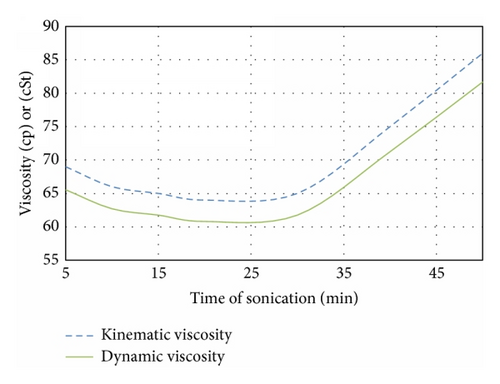
3. Results and Discussion
3.1. Permeability Impairment Predicted in Nonsonication
Hematfar et al. [16] presented experimental results of permeability reduction due to the asphaltene deposition during coinjection of alkane and oil in reservoir rock samples. Fortunately, the PSD of asphaltene versus flocculation time for this oil sample is available [11]. The input data of current asphaltene deposition modeling is obtained from combination of results of Hematfar et al. [16] and Najafi et al. [11]. The properties of rock and fluid are provided in Tables 1 and 2. To simulate their experiment core rock is divided into four sections. While the interstitial velocity is low because of the little value of flow rate (about 1 mL/min), θ is approximately set equal to θ0, that is, equal to 1. Figure 11 presents the results of modeling in comparison to the experimental results of Hematfar et al. [16]. The results of modeling are in reasonable agreement with the experiments. k0 is the initial value of permeability in which core is not damaged by the asphaltene particles. Obviously, more injection of oil and solvent leads to more severe formation damage. However, after about 3- or 4-pore volume injection, the permeability of porous media does not decrease any more. This can be because of the erosion effect due to higher interstitial velocity.
| Initial permeability | 66.3 mD |
| Initial porosity | 0.16 |
| Irreducible water saturation | 0.237 |
| Sphericity | 0.8 |
| Length | 13.8 cm |
| Core cross area | 11.46 cm2 |
| Crude oil API | 17.45 |
| Asphaltene content | 12.94 wt% |
| Asphaltene density | 1.26 gr/mL |
| Surface increment coefficient (γ) | 1 |
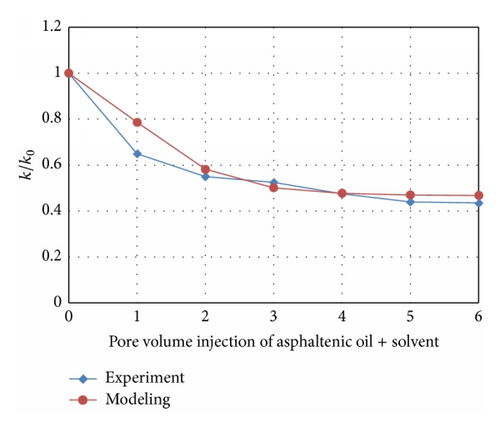
3.2. Permeability Impairment Predicted by Model for Sonicated Oil
By considering the changes of APSD during the ultrasound exposure, the modeling is again capable of predicting the permeability. Generally, sonication reduces the particle size and this leads to reducing the severity of damage. It should be noticed that, in this simulation, fluid goes under ultrasonic radiation first; then it is injected to the core and these processes do not happen simultaneously. Figure 12 presents the results of permeability prediction in different time steps of sonication versus time of flocculation. The model is run for the five-pore volume coinjection of asphaltenic crude oil and solvent and it has been assumed that the ratio of solvent is sufficiently high in order to have all asphaltene particles precipitated in the condition. As it can be seen in Figure 12 the nonsonicated sample shows continuous decrease in the permeability ratio of core whereas the sonicated samples show improvement in the permeability after about 90 min of flocculation. This can be because of the fact that asphaltene flocculation can be reversible when particles are exposed to ultrasound [11]. From a different point of view, Figure 13 shows the permeability value calculated by the model for each time step of flocculation by passing the ultrasonic radiation time. As it is shown in the figure, the sonication time of 20 minutes does not represent an appropriate permeability improvement and in some cases it may intensify the damage degree. There is no deterministic explanation for this behavior around 20 min of sonication; however, it can be said that according to Figure 9, after 20 min of sonication, a local maxima is visible in asphaltene particle average size. Larger particles block the flow path efficiently and reduce the permeability.
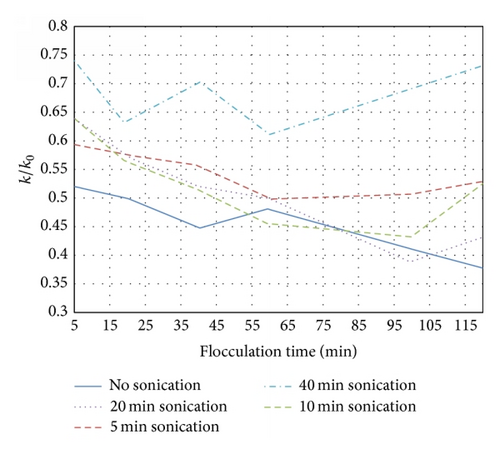
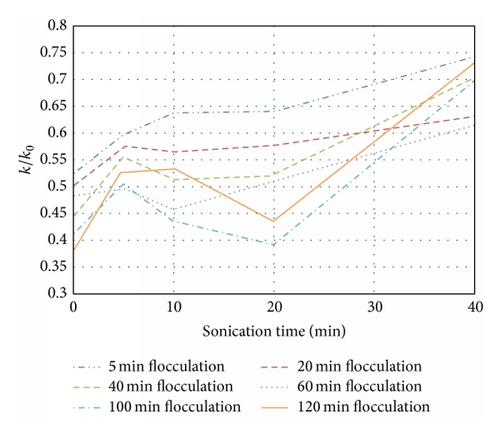
3.3. Effects of Uncertain Parameters of Distribution and Adsorption
It was mentioned that permeability impairment is a function of particle size distribution parameters. α and β are gamma distribution parameters, where β is known as the shape factor of distribution and α is related to the relative most probable point of distribution. Figure 14 illustrates the sensitivity analysis of permeability ratio over α and β. When β increases, permeability ratio falls. It means that more uniform and identical asphaltene particles cause less formation damage and vice versa. α is a parameter which indicates the centralization point of data. Larger alpha means larger particle size which leads to pore plugging and permeability reduction.
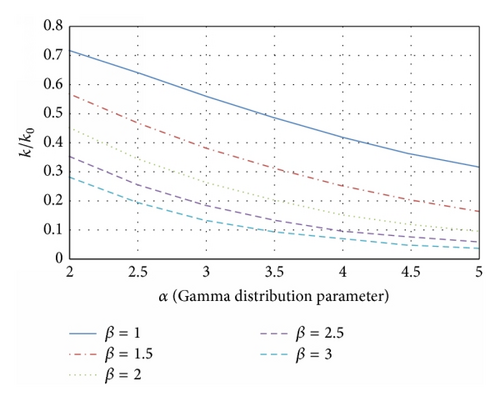
It seems reasonable to repeat this sensitivity analysis on the parameters containing uncertainty in order to evaluate their effects on the predicted permeability reduction ratio. γ and θ0 are two uncertain parameters related to asphaltene adsorption. Figure 15 shows the sensitivity analysis of permeability ratio over γ and θ0. θ0 indicates the tendency of particles to be adsorbed to the pore wall surface and γ is surface area correction factor when asphaltene particles attach to each other. In a constant permeability ratio, gamma and theta act inversely. It means that, by increasing theta, gamma decreases. Greater theta value means greater adsorption probability and this reduces permeability ratio. When γ decreases it means that asphaltene particles are packed and compressed to each other or to the pore surface and they do not increase the pore surface area during deposition. Thus, hydraulic radius is not significantly affected and permeability ratio increases.

3.4. Mobility Changes after Sonication
Although permeability is important parameter when assessing the sonication positive effects, viscosity changes should be considered. In this regard, we aim to calculate mobility which is the permeability divided by viscosity (M = k/μ). Therefore the optimization of the sonication time should be processed by attending the fact that the goal is to maximize the mobility of flow in the formation. As it has been discussed the viscosity of the sonicated crude oil after about 20 minutes of sonication reaches its minimum value. Also, after 20 min of flocculation, permeability ratio has a minimum. So, the optimum time of sonication cannot be found straightforwardly and requires deeper investigation. Figure 16 shows the mobility of fluid inside the formation versus time of sonication. In the 20th minute of sonication, mobility reaches its local minimum and this is not favorable. It means that, in the 20th minute of sonication, although viscosity is lower than other sonication times (Figure 10), lower permeability of formation restricts the flow (Figure 13) and consequently reduces the mobility.
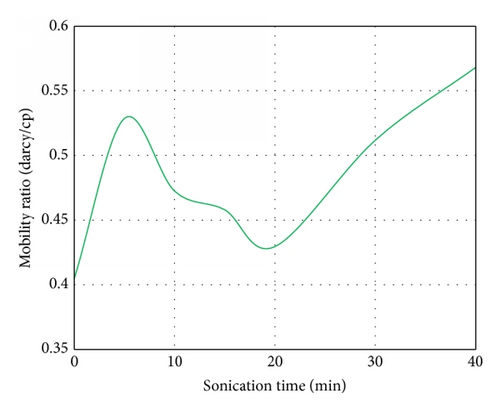
In the field scale, in order to perform ultrasonic stimulation on oil wells, powerful ultrasound generators are sent down hole and start to propagate waves through the near well bore area. The main goal of this treatment is to open the plugged pores and reduce the skin factor. In order to have a successful ultrasonic stimulation job, the probable decrement of mobility which is illustrated in Figure 16 should be carefully studied. The model presented in this study can be applicable to predict the effect of ultrasonic stimulation job on asphaltenic reservoir fluid near the well bore area. In order to apply in the field, it is suggested to upgrade the geometry of model from 1D to 3D and consider the attenuation of ultrasound while passing the through porous media.
4. Conclusions
- (i)
By affecting the asphaltene particle size distribution, ultrasounds are capable of remediating the permeability impairment caused by asphaltene formation damage.
- (ii)
The proposed model predicts the experimental data of permeability reduction during coinjection of solvent and asphaltenic oil into a core sample with a reasonable agreement.
- (iii)
Mobility reaches a minimum value after a specific time period of sonication. Here it is found to be around 20 minutes.
- (iv)
Sensitivity analysis showed that the parameters of gamma distribution, α and β, can affect the permeability ratio. Increment of both α and β will reduce the permeability of porous media.
- (v)
The results of this work can be helpful to better understand the role of ultrasound prohibition in dynamic behavior of asphaltene deposition in porous media. Also, the approach presented in this work could be utilized for the modeling of similar time-dependent particle induced formation damage such as invasion of mud solid particles into formation.
Conflict of Interests
The authors declare that there is no conflict of interests regarding the publication of this paper.




